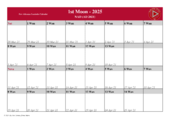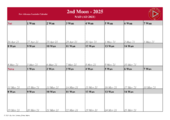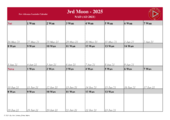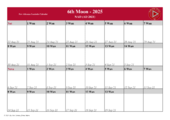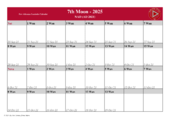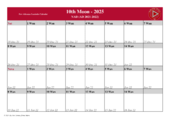New Athenian Lunisolar Calendar
Jump to navigation
Jump to search

The New Athenian Lunisolar Calendar is a calendar created by King Tyler Mullins of the Free Nation of New Athens. A lunisolar calendar is a lunar calendar with additional timekeeping rules being used to bring them into a rough agreement with the tropical(solar) year and thus with the seasons. The New Athenian Lunisolar Calendar is an official calendar of the Free Nation of New Athens, in addition to the Gregorian calendar.
Structure
Epochal date
| NA year | Equivalent CE years |
|---|---|
| 10 RBC | 15-4 BCE |
| 5 RBC | 10-9 BCE |
| 1 RBC | 6-5 BCE |
| 0 NAD | 5-4 BCE |
| 1 NAD | 4-3 BCE |
| 4 NAD | 1 BCE - 1 CE |
| 5 NAD | 1-2 CE |
| 10 NAD | 14-15 CE |
| 2000 NAD | 1994-1995 CE |
| 2025 NAD | 2021-2022 CE |
- The year 0 epochal date of the New Athenian Lunisolar Calendar is the date of the first full moon after the Northern Hemisphere spring equinox in the year 5 BCE. This date was chosen because the first day of the New Athenian Lunisolar Year correlates with the first full moon after the Northern Hemisphere spring equinox, and this year was chosen because the Gregorian calendar claims that AD 1 corresponds to the birth year of Jesus Christ, but this is widely believed to be false. Instead, this calendar claims that 5 BC corresponds to the correct birth year.[1]
Year
- The terms "novo anno Domini" (NAD) and "revised before Christ" (RBC) are used to label or number years in the New Athenian Lunisolar Calendar.
- The first day of the New Athenian Lunisolar Year correlates with the first full moon after the Northern Hemisphere spring equinox. This means in the Northern Hemisphere, each calendar year begins near the start of spring and ends near the end of winter. In the Southern Hemisphere, each year begins near the start of autumn and ends near the end of summer.
Month
- Each month has 29 or 30 days in accordance with the lunar cycle of that month.
- Each month is named in accordance with its index. For example, the first month of the calendar year is named "1st Moon" and the second month is named "2nd Moon," and so on.
- Every 2–3 years, there is an additional "leap" month, named "13th Month."[See Leap month]
- Each month is divided into 4 weeks. The first 2 weeks follow the moon's waning cycle. The second 2 weeks follow the moon's waxing cycle. Each week has up to 8 days, depending on the lunar cycle. The first week of every month starts with the full moon, followed by the first 7 days of the waning cycle. The second week contains all the remaining days of the waning cycle. The third week starts with the new moon, followed by the first 7 days of the waxing cycle. The fourth week contains all the remaining days of the waxing cycle.
- Each month has either 29 or 30 days because the length of the lunar cycle is, on average, 29.53 days. The length of the lunar cycle fluctuates because the Moon's orbit around Earth is not a perfect circle. In fact, the Moon revolves around Earth in an elliptical orbit with a mean eccentricity of 0.0549.[2] Thus, the Moon's center-to-center distance from Earth varies with mean values of 363,228.9 km at perigee to 405,400 km at apogee.[3] As a result, the length of the lunar cycle changes slightly(± ~0–6 hours)[4] each lunar month.
Leap month
- A leap month has to happen every 2–3 years because the tropical(solar) year is approximately 365.2422 days long and a synodic(lunar) month is approximately 29.5306 days long, so a tropical(solar) year is approximately 365.2422 / 29.5306 ≈ 12.36826 months long. Because 0.36826 is between 1/3 and 1/2, a typical year of 12 months needs to be supplemented with one intercalary, or "leap" month every 2 to 3 years. More precisely, 0.36826 is quite close to 7/19 ≈ 0.3684211 and several w:lunisolar calendars have 7 leap months in every cycle of 19 years.
- The Gregorian calendar month, which is 1⁄12 of a tropical year, is about 30.44 days, while the cycle of lunar phases (the Moon's synodic period) repeats every 29.53 days on average. Therefore, the timing of the lunar phases shifts by an average of almost one day for each successive month. (A lunar year lasts about 354 or 355 days.) This intercalation, or leap month is frequently controlled by the "epact", which is the difference between the lunar and tropical(solar) years (approximately 11 days).
- A "13th month" takes place seven times per 19-year cycle. This is known as the Metonic Cycle. Other well-known lunisolar calendars such as the Hebrew calendar and the Julian calendar also utilize this cycle for leap months.
Week
- The first week of each month will start with the full moon, followed by the first 7 days of the waning cycle. The second week of each month includes the remaining days of the waning cycle, which is always between 6 and 8 days long. The third week of each month begins with the new moon, followed by the first 7 days of the waxing cycle. The fourth and final week of each month includes the remaining days of the waxing cycle, which is always between 6 and 8 days long.
- Each week has up to 8 days because both two-week sections of the calendar month correlate with the Moon's waning or waxing cycle, and the length of a waning or waxing cycle, plus one full or new moon can total up to 16 days.
- The length of the waning and waxing cycle fluctuates monthly, depending on the moon's position in orbit around the Earth, but the total number of days of both cycles always adds up to be 29 or 30 days.
Days
- The day of the full moon is named "Naturday" and the day of the new moon is named "Novaday."[note 1] All other days are named according to that day's index in the waning or waxing cycle, whichever is relevant. For example, the 4th day of every month is "3rd Waning" as it is the third day in the waning cycle.
Date structure
- The full name of a calendar date contains the day's index of the waning or waxing cycle, followed by "Waxing" or "Waning, then the index of the moon of the calendar year, followed by "Moon", then finally the year according to the novo anno Domini or revised before Christ era.[See Year] Example: 1st Waning, 1st Moon, NAD 2025.
Calculations
- All calculations were completed using Java.
- Lunar phase calculations were made using the Commons-Suncalc library, a Java library for calculation of Sun and Moon positions and phases.
- Equinox calculations were made using Sualeh Fatehi's Sun Position Calculations, which can be used to determine the date of a solstice or equinox.
- Monthly and yearly calendar PDFs are generated automatically using this software, given a year in the Gregorian calendar, using iText 5, a library for creating and manipulating PDF files in Java and .NET.
Notes
External links
- Timeanddate.com - An explanation of the moon's lunar month
- Timeanddate.com - Annual moon phases and related data
- Almanac.com - Monthly moon phase calendar
- Nasa - Eclipses and the moon's orbit
- AstroPixels.com - Length of the Synodic Month: 2001 to 2100
- AstroPixels.com - List of Solstices and Equinoxes: 2001 to 2100 Greenwich Mean Time
- The Length of the Lunar Cycle - Analysis by Dr. Irv Bromberg, University of Toronto, Canada
- ScienceWorld.wolfram.com - Lunation
- Calculation of the Dates of New Moon and Full Moon of All Months of the Upcoming Five Years (2017-2021) - Md. Towhiduzzaman, A.Z.M Asaduzzaman
- How to compute planetary positions By Paul Schlyter, Stockholm, Sweden
- Astronomical Algorithms 2nd Edition - Jean Meeus
- Commons-Suncalc: A Java library for calculation of sun and moon positions and phases
- GitHub - Sualeh Fatehi's Sun Position Calculations
- iText 5 - A library for creating and manipulating PDF files in Java and .NET.
See also
References
- ↑ Humphreys, C. J. (December 1991). "The Star of Bethlehem a Comet in 5-BC and the Date of the Birth of Christ". Quarterly Journal of the Royal Astronomical Society, Vol. 32, NO.4/DEC, P.389, 1991.
- ↑ "Wieczorek, Mark A.; Jolliff, Bradley L.; Khan, Amir; Pritchard, Matthew E.; Weiss, Benjamin P.; Williams, James G.; Hood, Lon L.; Righter, Kevin; Neal, Clive R.; Shearer, Charles K.; McCallum, I. Stewart; Tompkins, Stephanie; Hawke, B. Ray; Peterson, Chris; Gillis, Jeffrey J.; Bussey, Ben (2006). "The constitution and structure of the lunar interior". [[w:Reviews_in_Mineralogy_and_Geochemistry Reviews in Mineralogy and Geochemistry]. 60 (1): 221–364. Bibcode:2006RvMG...60..221W. doi:10.2138/rmg.2006.60.3. S2CID 130734866. [1]] from the original on 19 August 2020.
- ↑ Murphy, T.W. (1 July 2013). "Lunar laser ranging: the millimeter challenge" (PDF). Reports on Progress in Physics. 76 (7): 2. arXiv:1309.6294. Bibcode:2013RPPh...76g6901M. doi:10.1088/0034-4885/76/7/076901. PMID 23764926. S2CID 15744316.
- ↑ Bromberg, Irv (24 January 2018). "SOLEX Lunar Cycle Duration minus Mean Synodic Month (atomic time)" (PDF). University of Toronto, Canada.
